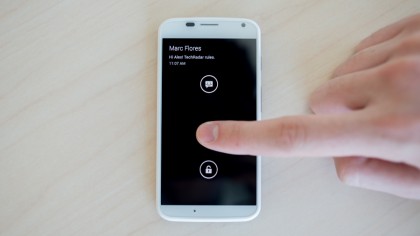Why you can trust TechRadar
One of the key features of the Moto X is its in-hand feel. It is quite hard to describe how relatively small it feels compared to most of today's large-screened flagship devices not to mention the likes of the Samsung Galaxy Note, which seems gargantuan in comparison.
Motorola has managed to squeeze a nice 4.7-inch 720p AMOLED screen into the Moto X despite it being only marginally larger than an iPhone 5S.

Relative compactness is not the only trick the design of the Moto X has up its sleeve. The back curves almost exactly to the shape of your hand, with its maximum thickness being just a little above the center of the phone making it feel molded to you when holding it.
This is most definitely a one-handed use phone, unlike most higher-end Android devices, and in many ways the Moto X is more comfortable in one hand than even the iPhone.
Material choices can often be highly controversial, but Motorola has done really well here. Yes, the Moto X is a plastic phone, but it uses good quality plastics. It feels warm and inviting unlike the cold calculated precision of the iPhone 5S.
Say cheese
The 10MP camera on the back sits flush with the casing, so there are no annoying camera humps to work your fingers around, but it does still present a slight problem as it is quite easy to end up touching the camera in normal use.
Motorola has used an unusual type of sensor including the use of a so-called Clear Pixel, which is meant to help in low light situations and generally helps in exposing pictures more accurately.
Sign up for breaking news, reviews, opinion, top tech deals, and more.

Unfortunately, as we will see later on, this hasn't worked. On release in the US, the Moto X was panned for taking very poor pictures. It has had a series of updates since then, and this UK model has the very latest camera software. Motorola has unfortunately not managed to live up to expectations though.
Pure Android?
Almost uniquely amongst the Android manufacturers, Motorola has taken a very simple approach to the software on the Moto X. What we have here is essentially stock Android 4.4.2 KitKat with just a few Motorola enhancements.
The changes are almost entirely positive, and Motorola has clearly thought about how people use their phone on a daily basis.
To a great extent, these changes are possible due to the unique hardware customisations Motorola undertook when designing the Moto X.
While the basic chipset is a Snapdragon S4 Pro-derived dual-core design, Motorola has added two contextual processing units.
One of these is for natural language processing and the always listening feature of Touchless Control and the other allows the Moto X to use all its sensors to understand when the phone is out of your pocket, for instance to show Active Notifications as well as to enable the camera flick gesture.

Touchless Control is Motorola's name for one of the most interesting features on the Moto X. Even with the screen off, the phone is listening and waiting for you to say "OK Google Now" - at which point the screen will light up and you can tell it to perform various actions including sending a message, making a call and providing directions through Google Maps.
Before using it, you must train the phone to understand your voice, and once that is done, in theory, it only responds to you.
I found it works very reliably, and is a lot better than expected. I had very few false positives where you would find the phone ready to accept a voice command even though you hadn't asked it to do anything.
Active Notifications makes use of one of the great properties of an AMOLED screen, the ability to light up just part of the screen without having to power the entire display.

When a notification comes in, if the screen is off, the Moto X will flash up on the screen the app icon that the notification came from.
This icon breathes, with the screen going on and then off and then on again over a period of a few seconds. It is a very low-power way of showing on screen notifications.
Perhaps the best part of Active Notifications is that the Moto X will also monitor a motion sensor in the phone, and if it senses you picking the device up off the table, the screen comes on so you can unlock it.
It uses the light sensor to know when you take the phone out of your pocket and does the same thing. All this means I has hardly ever had to use the power button to switch the phone on, it is on and ready for me like magic.
The other main trick that the Moto X performs is when using the Motorola Assist app, it can sense when you are driving and start to read out your text messages. I found this to be fairly reliable but a significant battery drain. Nonetheless, another useful addition from Motorola.
